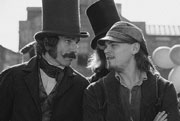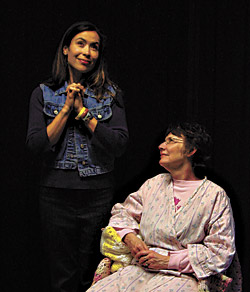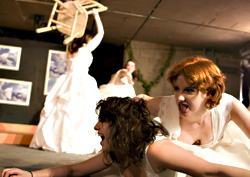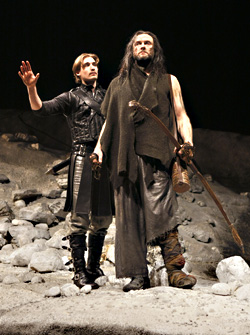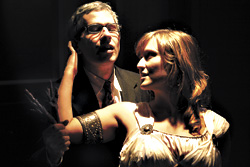MARTIN SCORSESE’S sprawling epic about his old neighborhood’s mean streets circa 1846-63 is the worst must-see movie of the year. Important yet incompetent, Gangs of New York could ruin his blockbuster career and exile him to the art house. But you’ve never seen anything like it, and you’ll never see anything like it again, because it’s too expensive. (The film opens Dec. 20)
Scorsese re-created 15 acres of Manhattan history with fanatical detail—the wooden firetraps begging to be set ablaze by angry occupants; the sloppy docks disgorging “wooden coats” (coffins) from the Civil War while accepting clueless immigrant soldiers aboard to their own deaths; the mucky streets patrolled by pigs, thieves, “stargazers” (prostitutes), two sets of feuding cops and firemen, and gangs like the Plug Uglies.
The constituent sets are equally stunning: the central brawling plaza of the Five Points; a burnt-out building draped in icicles; Sparrow’s Chinese Pagoda, a nightclub/opium den/theater; and Satan’s Circus, the brothel headquarters of the movie’s bad guy, Bill “the Butcher” Cutting (Daniel Day-Lewis with a vaudevillian villain’s handlebar mustache and a glass eye emblazoned with an American eagle). You have to look hard and fast to grasp all the pricey, nifty touches: Near Bill the Butcher’s brothel throne, you’ll see a jarful of human ears; and the roots of a tree grow through the brothel’s ceiling—a skeletal effect meant to stress Bill’s underworld street cred.
Hundreds of men pummel each other, and every one of them had an eye-gouging/ ear-biting coach; there’s nary a computer-generated thug in sight (which reportedly caused George Lucas to cluck reproachfully). The 100 actors with speaking parts— including Leonardo DiCaprio, playing the good guy, Amsterdam Vallon—were policed by a period-language coach, Tim Monich. Cinematographer Michael Ballhaus, who’s made as many great films as Scorsese, mostly with him, lights it all ࠬa Rembrandt, in somber hues flickeringly, smokily illuminated—darkness visible, blackness shot through with brilliance.
But the camera’s artful moves, bereft of narrative momentum and vivid characters, lack the impact Scorsese achieved in GoodFellas, or even Casino, which flowed like life and carried us away. When Henry Hill acquires a coke habit in GoodFellas, the movie does, too. When Gangs swoops through the Five Points, it’s a stiff history lesson: lots of stop and not much go.
Scorsese boasted to Film Comment about defying conventional use of period music in GoodFellas: It was all selected for emotional impact, not the usual literal-minded match-the-tune-to-the-year exercise. But Gangs inserts period music professorially. Attention, class: Tap dancing was invented in the Five Points by blacks exposed to Irish dance; note how, in the tap-dance scene, Bill the Butcher’s offhand comment, “A jig dancing a jig,” heralds a turning point in our culture. There is more spontaneous life in Steeleye Span’s record of “New York Girls” (with Peter Sellers’ amazing ukulele solo and comic vocals) than in the version Scorsese stages here. Note, class, the implications of a traditional tune about a rube getting Mickey Finned and robbed by hookers. It will be on the test.
Gangs is all about Big Events enacted by characters as generic as anything the most philistine studio MBA ever inflicted on a summer action picture. Bill the Butcher is silly, piratelike, not remotely scary. His habit of tapping his glass eye with a knife does not resonate on-screen. Leo’s Amsterdam Vallon is an abstraction invented by original screenwriter Jay Cocks under the influence of a Springsteen song about a Hero Who Rises to Save the People. In the long, dull opening gang-fight scene, the boy Amsterdam sees his priest father (long, dull Liam Neeson) lead the Irish gang against Bill’s native-born Americans. The nativists hate the more recent Irish immigrants, who take their jobs; in the film’s final gang war, the Irish riot against the Civil War draft because they don’t want to fight for the right of blacks to take their jobs in turn. (Class, discuss the irony.)
Bill kills the priest. Amsterdam grows up, digs up his daddy’s dagger, and vows vengeance against Bill. When Amsterdam saves Bill from an assassin during a reactionary staging of Uncle Tom’s Cabin (a beautiful scene, presided over by a puppetlike Abe Lincoln dangling from the rafters), Bill takes him under his “dragon’s wing” as a surrogate son. This should be rich and tense, but all energy dissipates in a series of disconnected vignettes and vague allusions to history. Amsterdam also takes a fancy to one of Bill’s girls, Jenny (Cameron Diaz), a “turtledove” (a woman who dresses up, slips into rich folks’ homes, plunders, and escapes). Diaz’s turtledove heist is cool, but her love scenes with Leo were skimpy enough to require reshoots, and they’re still quite dead. Travolta had more chemistry with Lily Tomlin. And Jenny is simply not integrated into the plot.
Bathe your eyes in the glory of Brendan Gleeson’s performance as Monk, the thug who kicks open the door in the dazzling opening shot of the first gang fight (which seems an anticlimax after that indelible first image), but don’t expect the story to give this character his due. How can you lose with the likes of Jim Broadbent as Boss Tweed and John C. Reilly as a gangster-turned-cop? Answer: by letting their characters register intensely, then trail off into insignificance. As Amsterdam’s henchman, Johnny, poor Henry Thomas gets a role so amazingly irrelevant and unresolved he seems to have fallen into the scene from E.T.’s bicycle, blinking in surprise.
Scorsese made history immediate and intimate in The Age of Innocence. Here he fixes his eye on the big picture and the teensiest detail, neglects character and story, and winds up with a few immortal scenes mired in a sea of dramaturgical mud. Let’s hope his career doesn’t wind up in a wooden coat.
